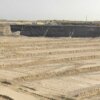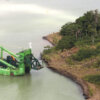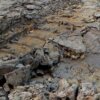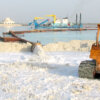Stiffness of subsoil and fill will define the deformation or strain which occurs during and after the construction of a reclamation site.
Stiffness and deformations
Stiffness is defined as the resistance of the fill material to stress-induced deformation. The strength of a soil is linked to its deformation, that is, its peak and residual shear strength. A failure is the occurrence of large and uncontrolled deformations.
Defining the stiffness of the subsoil and of the fill material are both important and yet at the same time estimating the stiffness of subsoils and hydraulic fill material are quite different matters.
In particular the presence of a soft, cohesive subsoil below the fill may cause both long-term consolidation settlements of the fill surface as well as horizontal deformations near the edges of the fill mass. These deformations can adversely affect anything built upon the reclamation area.
Short-term undrained stiffness of saturated fine-grained soils will be higher than the long-term stiffness. Stiffness also depends on the stress history or on the over-consolidation ratio. The stiffness of soil at a virgin loading is lower than the stiffness at unloading and reloading conditions. Multiple loading cycles can cause degradation of the soil strength. In certain areas, like earthquake zones, this should be taken into consideration.
Estimating the deformations
The deformation and consolidation behaviours of a reclamation site should be examined and estimated for several reasons:
- to predict the volume of the fill material need to guarantee a reclamation level during construction and/or in the long term as stipulated by the client;
- to predict the residual settlement that the reclamation area will undergo after area has been handed over to the client and when construction of superstructures takes place;
- to predict the differential settlements that can occur between different zones of the reclaimed area, which can be more problematical than absolute settlements;
- to prediction the strength increases of compressible, natural soil layers as a result of consolidation.
A design of a reclamation area should include predictions of expected deformations to determine if they are acceptable or if soil improvement is necessary. Also the design should determine the required thickness of the fill, considering the final surface level of the area, construction settlements and post construction, that is, residual settlements.


















